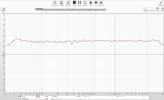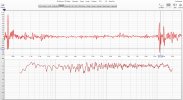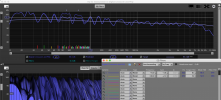I recently bought a MiniDSP 4x10HD active crossover / PEQ and have been playing with different setups. Below are REW measurements with the original analog active crossover and with the MiniDSP.
These measurements are all taken at the listening position which is 11 feet from the speakers. The room is 20 feet wide by 30 feet long with an 11 foot cathedral ceiling and there are many irregular room surfaces on the back wall behind the listening position. The entire front wall behind the speakers is covered by thick drapes and the front 2/3rd of the room is carpeted. This room could be considered an LEDE room with the listening position in the rear live 1/3rd of the room. The speakers are about 1/3rd out from the front (long) wall and about 6 feet from each side wall, and the listening position is 11 feet from the speakers.
The speakers are Altec Lansing A7-500s and both the LF and HF drivers are driven by vacuum tube amplifiers, the HF being an SET. The subwoofers are four JBL 18" drivers, two per side, each in an 8 cubic foot enclosure and operated in stereo with 1000 watts (500 per side). These subs are positioned in the front left and right corners of the room, behind the mains.
This is the response with the original analog crossovers (12dB per octave Linkwitz-Riley).
View attachment 168711
And this is the response with the MiniDSP 4x10HD (12dB per octave Linkwitz-Riley).
View attachment 168712
The MiniDSP 4x10DH obviously benefits from the PEQ. However in actual listening, there is little or no sonic difference between the two, and I have decided to keep using the analog crossover, however it is very easy to swap between the analog and digital if I want to.
The main problem with the MiniDSP is that my gain structure is configured in such as way that most of the signal gain occurs in the preamplifier (vacuum tube) and comparatively little in the power amplifiers. This is done to reduce hiss and other noise from the extremely efficient horns to inaudible levels at any more than with my ear right in the horn mouths. This high signal level hitting the MiniDSP causes it to clip at listening levels below the maximum I listen at, which can be very loud and/or bass heavy with pipe organ music.
Also, even though there is no real 'technical disadvantage' to the extra analog / digital / analog conversions when going through the MiniDSP, doing so just bothers me in my heavily analog based system, although a good percentage of my listening is to digital sources.
For those interested,
this is the .mdat file for REW. the microphone used is the MiniDSP UMK-1.



